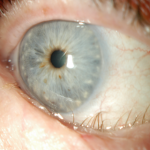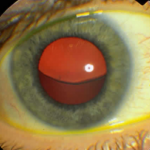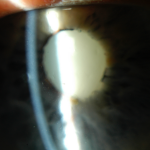THE MIRACLE OF
COLOUR VISION
COLOUR CONSCIOUSNESS
Colour vision is a secondary property of object consciousness, which means that if there is no perception (ie no conscious viewer) there is no colour. What exists between the object and the viewer is merely radiance of a particular spectral composition. Our conscious perception of a ‘pixel’ within an extended optical image is shaped by a ‘spatial gestalt.’ There is no mathematical manipulation of the component spectral radiance emitted from the pixel that can predict an observer’s colour consciousness. Neither can the colour perception of that pixel be accurately predicted by simply integrating the spectral properties of the background. Psychometric analysis has revealed that object colour consciousness is biased by a subconscious adjustment which integrates not simply the chromatic properties of the background, but rather the way those properties inform the likely spectral properties of the overall illumination. There is evidence that this behaviour is determined by both evolved (‘hard wired’) brain functions and conditioned (‘software’) properties that operate on the raw stimulus input.
Object colour consciousness is also shaped by a ‘temporal gestalt’ that integrates stimulus changes over time, involving hue, saturation, and brightness. More interestingly, visual perception in general, and object colour perception in particular, are shaped by a ‘logical gestalt’ that constrains visual perception to within a logically coherent domain of possibilities; partly determined by memory and viewing context; that are not intrinsic to the spectral input. Visual perception is actively shaped to accord with what we already know prior to the visual stimulus.
The evidence for these non-intuitive claims comes from subjective psychological and physiological experiments including Edward Land’s retinex experiments (https://sciencedemonstrations.fas.harvard.edu/presentations/lands-retinex-theory-experiment), colour contrast studies (e.g Lotto RB, Purves D. An empirical explanation of colour contrast. Proc Nat AcadSci USA 2000;97:12834–9), and visual illusions such as Adelson’s checkerboard shadow (https://en.wikipedia.org/wiki/Checker_shadow_illusion) and the hollow mask illusion (https://www.youtube.com/watch?v=0QgoX78q-0Y). The standard paradigm of visual consciousness (naive realism) holds that a feed forward process starting with chromatic contrast within ganglion cell receptor fields is both necessary and sufficient for visual consciousness. The subjective data contradicting this standard paradigm is now so overwhelming that we need to revise it. All aspects of visual consciousness, including object colour, arise from top down processes.
Bottom up processes feed into visual consciousness, but as any one with Charles Bonnet syndrome will attest, they are neither necessary nor sufficient to determine it.
This is a very counterintuitive conclusion, but it is well supported by the evidence – in contrast to the embedded assumption about visual perception in our language – ‘naive realism’. A statement like ‘the grass is green;’ implying a correspondence between intrinsic properties of grass and our perception; is scientifically misleading. But if I insist on expressing my belief with the phrase ‘my perception of the grass is green,’ our conversation may not go well. So, to facilitate conversation, we resort to expedient shortcuts at the expense of accuracy. Philosophers delight in pointing out where this habit leads us astray.
Now to return to the topic of colour: we might ask, ‘what functional advantage determined the evolutionary success of trichromatic colour vision in humans and a very few primates?’ The simplest explanation is that achromatic object perception; or shape recognition based entirely on luminance clues; is less capable of generating unified perceptions. For example, imagine a theoretical potential evolutionary ancestor, without colour vision. She is looking through a thicket of tree branches toward a forrest, within which a hungry leopard hides. Her achromatic (grey scale) analysis of the scene did not enable her to discern ‘likeness’ across discontinuous parts of the scene, so she could not generate a perception of a leopard. Hence extinction. Compare that with a theoretical ‘successful’ ancestor with genes that enabled trichromatic perception, providing her with the capacity to discern a colour similarity between the disconnected areas of ‘leopard’ that were visible through the trees. She produced a unified perception of a leopard hiding and had a higher chance of passing on her genes – an instance of ‘natural selection.’
A sophisticated interpretation of the environment began before the capacity for language had developed. It is likely that our evolutionary psychology, which led to our capacity to assign categorically unifying values to arrays of perceptual stimuli, made it useful to assign colour categories to visual perceptions since unifying perceptions according to colour helps us to form reliable beliefs about the world. Once language and social networks developed we learnt to communicate our beliefs more efficiently than other animals, and to pay more attention to differences between colour categories. It is a historical anomaly that
Newton’s rather illogical ‘colour octave’ has become normative, since it fails to accurately express our categorical colour perceptions – as evidenced by different menus of colour names across cultures. The ‘idea’ of colour supervened on spectral contrast detection as a way of thinking and talking about the perception. The aesthetic appreciation of colour is a cultural rather than a physiological skill.
The problems we have in discussing our colour perceptions in light of our scientific understanding of the world are a specific and especially clear example of a wider problem relating to how we talk about consciousness. ‘Colour conversation’ clearly illustrates how naive realism and empirical facts about the world come apart when analysed scientifically. Whenever this happens the smart money is on the scientific view of reality. Unfortunately changing the way we talk about consciousness is a social privilege that must be earned. Even if linguistic pedantry was an acceptable mode of discourse, truth making in public is frequently denied to the cognoscenti. So grass is not about to lose ‘its’ greenness.
The button below will download a pdf copy of an article describing the correct use of the Ishihara plate test
COLOUR PUBLICATION ARCHIVE
Amblyopia involves functional suppression of the parvocellular signal at the lateral geniculate nucleus but the koniocellular signal, as measured by the C test, is preserved. The article below describes the use of the C test in amblyopia
Littlewood R. Normal Tritan Discrimination in Amblyopia Suggests Preservation of Koniocellular Function. International Journal of Ophthalmology & Visual Science 2018;3(3):43-46.
The button below will download a pdf copy of an essay entitled “The history and physiology of human tritan perception.” This discussed the evolution of human colour vision in a narrative style that non scientists may find accessible.
The button below will open a you tube video link to the 2021 Perth Eye Foundation lecture. In this talk I attempt to clarify some metaphysical confusion, briefly discuss the evolution of human colour vision, and provide arguments in favour for B/Y instead of R/G colour testing in acquired visual disorders.

Clinical colour testing for tritan contrast is important in any acquired colour vision disorder. Of the tritan contrast plates presently available only the C Test isolates the koniocellular signal from the parvocellular signal sufficiently to provide a dominantly tritan response. It also provides an ordinal score, which is useful in monitoring acquired colour vision defects. To learn more about the C Test or download a pdf visit the C Test page on this website via the menu link above.
Every Eye Matters






© 2020 All content remains the property of Dr Ross Littlewood without written permission for re-use20
Lorem ipsum dolor sit amet, consectetur adipiscing elit. Ut elit tellus, luctus nec ullamcorper mattis, pulvinar dapibus leo.